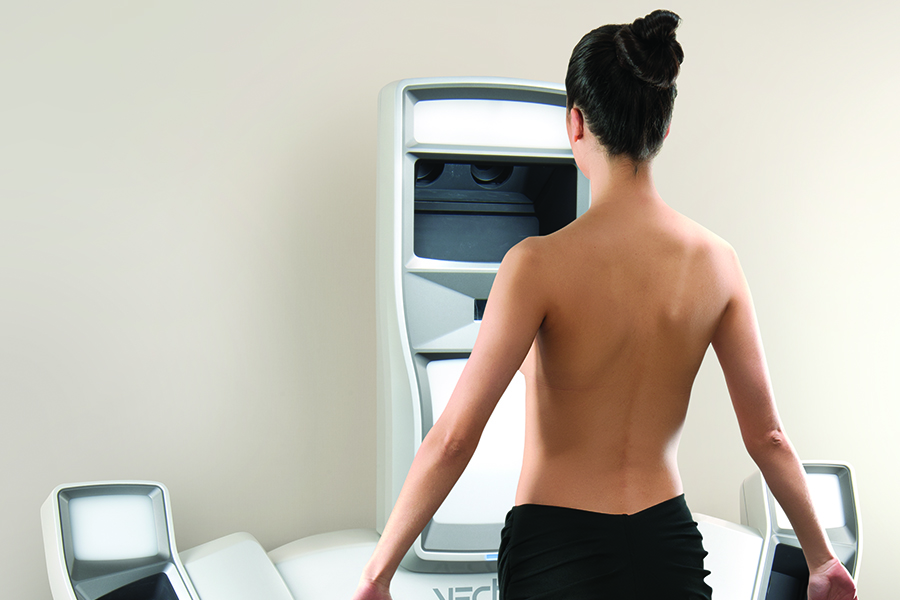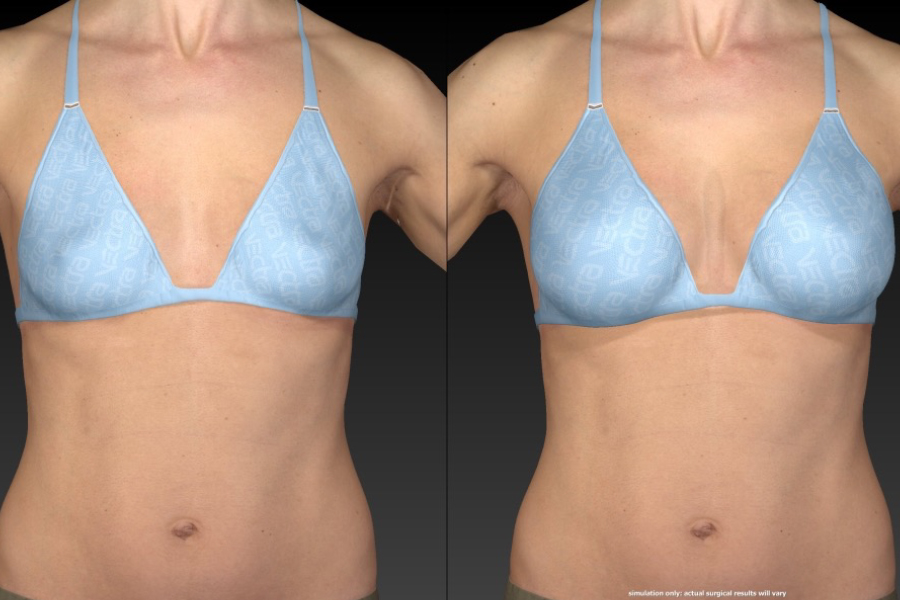Patients Fully Recover from This Breast Augmentation Procedure in a Single Weekend. Here’s Why Philly Is Embracing It

Even a few years ago, breast augmentation, while a popular procedure, could still seem out of reach for many people, an option primarily for celebrities or those with the luxury of extended downtime. But as cosmetic procedures become increasingly commonplace, there’s a growing understanding that everyone should get to choose how their body looks. As a result, an increasing number of people interested in breast augmentation have looked to recent advancements in the field, to technologies and techniques that make the procedure more personalized to the individual’s body, all while making the process more convenient and accessible for the patient.
“I think that breast augmentation in 2024 is an example of how technology can really impact the improvement in outcomes and aftercare and comfort for our patients,” says Dr. Louis P. Bucky, founder of the Bucky Body Center and Bucky Plastic Surgery in Philadelphia.
At Bucky Plastic Surgery, Bucky has set standards for how to bring together the latest wave of innovations to create a smooth experience (including recovery from surgery in a single weekend) combined with transformative results. Thanks to these innovations, many Philadelphians are receiving breast augmentations that are more natural, subtler, and improve their overall profile, without their colleagues or even friends and family knowing they underwent a procedure.
But to get these results, you have to know what to look for and who to go to for help. To find out how to determine which approach to breast augmentation will work best for you, and what to look for in a great breast augmentation surgeon, we spoke to Bucky about the current standard of care. With the right approach, even if you’ve never considered breast augmentation before, now may be the time to check it out.

4D imaging enables physician and patient to get on the exact same page about their desired look.
Deciding to Get Treatment
Today’s breast augmentation procedures shouldn’t require a big leap of faith. In previous years, some physicians required patients to rely on the physician’s advice and imagination to get a sense of what they’ll look like after the procedure. Now, the experience is much more personalized.
“I think the leap of faith, 20 years ago, was much higher. Patients would just have to put a lot of trust in the doc,” Bucky says. “Now the patient has a much bigger say. And therefore the anxiety associated with the operation is much lower.”
According to Bucky, that’s a major driver behind why more people are getting implants. Rather than a major change to their body, it’s now often a quality of life decision.
“In my practice, the size or volume of implants has gone down a little bit overall. It’s typical that a patient wants to look good in a bathing suit, or wear all the clothes they want comfortably, and not have to fiddle with a padded bra,“ Bucky says.
For example, a recent patient, Lauren, didn’t need more volume or a complete transformation–instead, her proportions were making it so her clothing selection was limited, particularly for summer vacations or formal events such as weddings.
“I’ve always worn small sizes, zero or two. And as I got to my 30s, my breasts did not fill out the way the rest of my body did, and I started to feel kind of out of proportion,” Lauren says. “Formal wear was a lot harder. Swimsuits were really hard. If it was something strapless, it would be something I would avoid, because it wouldn’t fit right.”
After researching the issue, Lauren found that Bucky’s approach aligned with what she was looking for–an individualized solution that wasn’t simply looking to maximize breast size. So she decided to take the first step–which was easier than she realized.
Starting the Discussion
The first step didn’t even require her to leave her home. Bucky begins most patient relationships through telemedicine.
“We can get about 80 percent of the preparation done through telemedicine, which is really convenient for the patient from a time and comfort perspective. We discuss before-and-after photos from previous patients and have a discussion about expectations. The only aspects that we can’t do are the actual measurements and computer imaging,” Bucky says, explaining that even that initial conversation is specific to each patient. “I always ask what their goals are to try and determine how to maximize their quality of daily living. But I also tell patients that the ideal implant for you, depending on your dimensions, may not be what you want or what I want, but what your breasts and chest tells us you should be. Because there’s a certain width to their breast, there’s a certain distance from their crease to their nipple, and therefore, there’s an implant that should fit that, given those parameters.”
Once the expectations are set, the patient will need to come into the office for imaging, to find out the exact approach that will work for them. These approaches are far more specific than they’ve been in the past, thanks to innovations in the implants themselves.

Imaging scans can show how patients look before and after the procedure with a high degree of accuracy and detail.
Finding the Perfect Size
Implants are no longer defined by size alone–they’re now made according to different widths, lengths and shapes, to better serve the patient’s individual breast type.
“Even though implants are categorized by volume, you can match the dimension of the implant to the dimension of the breast. It’s very similar to the way we fit shoes,” Bucky says. “And if you match the dimension of the implant to the dimension of the breast, then some of the issues that used to be associated with implants like implant malposition, stretch deformities and other complications tend to go away.”
Bucky considers not only how to achieve the best shape and size for the person’s individual body, but also how to do so given the current composition of the breast. For patients with less breast tissue, a combination of the right implant and additional fat taken from other areas of the body can result in a natural look—something that patients who wanted to increase their size would often struggle with in the past.
On the other hand, for patients with more volume but less projection, the correctly shaped implant can create the right profile without weighing you down. This process of individualized discussion was critical to Lauren. “I didn’t have small breasts, but I did not have a lot of projection. And in my clinical exam, Dr. Bucky saw what I was talking about. I wanted as small of an implant as possible, while going up only one or two cup sizes, just to get the projection results I wanted,” Lauren says, noting that the collaborative process got her to exactly where she wanted. “There was definitely an element of feeling like I was in control. I was very specific about how I wanted the surgery to go, what size implant I was willing to go up to. And he completely took my direction.”
But Lauren didn’t need to solely rely on her conversation with Bucky–thanks to a key innovation in modern breast augmentation, she could see what she’d look like in real time.
Seeing is Believing
After the initial consultation process, the patient will get a clear understanding of what they’ll look like after the final results of the procedure, thanks to the VECTRA XT 4D body scanner. The scan allows patients to see what the augmentation will look like on a virtual projection of their body, accounting for all the idiosyncrasies of their individual body type. A picture is worth a thousand words, and Bucky notes that the scan makes clear to patients with a high degree of accuracy how the implants will cause the shape and size of their breasts to shift when they’re placed. It also gives the patient a clear understanding of how the implants will affect their overall profile, a key factor to consider when it comes to satisfaction.
“A smaller implant goes a longer way for women as they age, as opposed to a larger implant that could make them feel top-heavy,” Bucky says. “On the other hand, patients who are at the gym more don’t want to be too full up top. We make sure the implants fit their desired overall look.”
This step allows the patient to fine tune their expected results–and makes sure Bucky and the patient are on the exact same page, making everyone feel at ease with the decision.

Dr. Bucky (right) is a standard-setter in the field.
A Seamless Surgery
The scan not only helps the patient realize their ideal look–it helps Bucky prepare seamlessly for surgery. Because the scan gives Bucky a sense of what he has to navigate during surgery, he doesn’t have to create a large incision, and he typically requires only a small, inch-and-a-half opening under the breast.
That innovation is complemented by an important invention called the Keller Funnel, developed around the same time and often used in conjunction with the 4D body scanner. In addition to enabling the small incision, the funnel allows for a no-touch placement of the implant and minimal maneuvering, reducing the risk of infection and ensuring Bucky doesn’t have to go deep into the body to place the implant.
“It’s lubricated so it allows the implant to be inserted without any friction through a much smaller incision. And it protects the implant from touching the skin of the patient,” Bucky says. “This insertion device makes it much less traumatic on the implant, so the implant has less fatigue, and it’s much easier for the patient so they have less discomfort.” Scarring is also kept to a minimum, and since Bucky is also a cosmetic surgeon, anti-scarring agents are a natural complement to the procedure.
A Rapid Recovery
Thanks to this technique, the surgery only requires a half hour and no narcotics, a feature that Bucky says should be a must when looking at any breast augmentation surgeon.
“I can’t imagine doing a breast augmentation that takes an hour or more. Length of time does not mean greater care–it means less experience and less thoughtfulness around the operation,” Bucky says. “Typically, we don’t even use narcotics during surgery. Patients just take Advil or Tylenol and may occasionally have a muscle relaxer and that’s it. Many people go out that night.”
Altogether, this results in a surgery that can be recovered from in a weekend–a high standard that Bucky Plastic Surgery has uniquely achieved.
“If a physician tells you the recovery is long, it means they’re not utilizing all those aspects that we’ve discussed,” Bucky says.
But as long as you identify a surgeon who brings together all these techniques, the results can not only be transformative, but fit easily into your schedule and your life. While in the past, patients may have carefully scheduled a surgery around work days, vacations and the changing seasons, now patients can go in for a consultation in spring and finish the process before summer. Two months after the surgery, Lauren now feels that she can wear whatever she wants–and that means she can feel ok going wherever and doing whatever she wants.
“I’m super excited with the results. I actually have my best friend’s wedding in September, and I have my bridesmaid’s dress, and where before I would need to personally make all these adjustments to fill out the top, even with it altered to my size, now I don’t even have to wear a strapless bra with it,” Lauren says. “I would do it again in a second because of how smooth everything went, how respected I felt, and how good it feels to look the way you want to look.”
This is a paid partnership between Bucky Body Center and Philadelphia Magazine